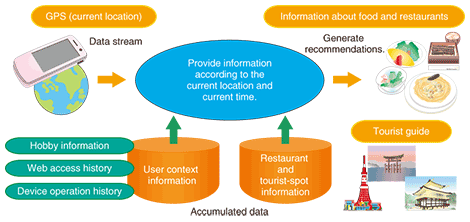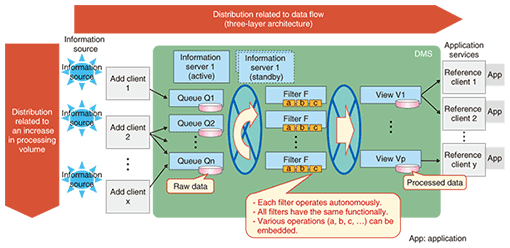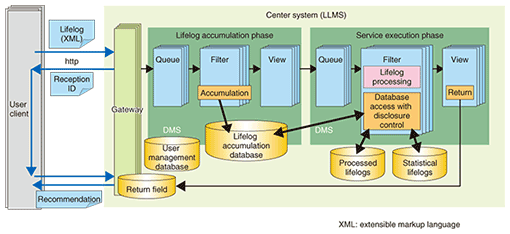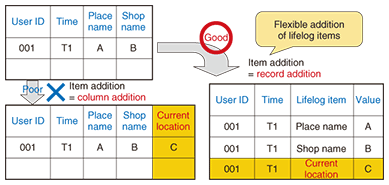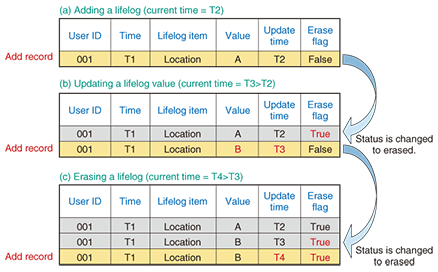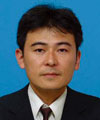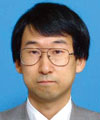 |
|||
|
|
|||
|
Feature Articles: Platform Technologies for Services that Utilize Lifelogs Vol. 9, No. 1, pp. 22–26, Jan. 2011. https://doi.org/10.53829/ntr201101fa4 Data Stream Management Technology for Accumulating and Processing LifelogsAbstractIn this article, we describe our data stream managing and processing technology, which accumulates and manages streaming log data sent from sensing devices and personal cellular phones and processes it nearly in real time. We also introduce the architecture of our Lifelog Management System (LLMS), which provides the technologies needed to support lifelog-based services.
1. IntroductionServices that offer attractive new functionalities through the use of various time-series data as lifelogs have been drawing attention. Such data includes time-series data generated from sensing devices, histories of personal activities collected from modern cellular phones, and log data accumulated in each information system. As shown in Fig. 1, users’ location data collected by phones equipped with a GPS (global positioning system) function and users’ context information such as their profiles and/or device operation histories can be accumulated. When all this data has been processed, users can be provided with personal recommendation services that suggest restaurants and tourist spots.
Such advanced services require the implementation of the following functions. - Accumulation and management of enormous amounts of lifelog data collected over long periods of time on servers on the network - Various types of processing in nearly real time taking into account the user’s context - Scalability for handling additional users and their requests - Processing algorithm alteration or addition without service operation suspension This article introduces our basic technology that helps to realize lifelog-based services. 2. Write-once read-many-times data management systemNTT Cyber Space Laboratories has been developing a write-once read-many-times data management system (DMS); it continually accumulates and manages time-series data, such as lifelog data, as a data stream and provides information to users after processing and integrating it. DMS can subject data streams to pre-registered processing algorithms every time new data arrives, so it can offer near-realtime event processing. DMS can be run on clusters of personal computers (from one to a few hundred). It offers dynamic scalability of data processing (growth in scale) when information sources need to be added or the data volume increases. It also supports dynamic changes in processing algorithms (functionality enhancement) for data streams that arrive constantly. As shown in Fig. 2, DMS has a three-layer architecture consisting of queues, which receive and accumulate data; filters, which process received data and integrate accumulated data; and views, which provide processing results for each application.
(1) Queues Each information source is associated with a different queue. Each queue receives and accumulates a data stream generated from the information source via add client. A new information source can be supported by adding a new queue. (2) Filters Filters pull data from queues, apply the processing algorithms set for each information source to the data, and send the processing results to views. Each filter determines which queue it should get data from on the basis of the data arrival rate. If the data volume and number of processing operations increases, the processing throughput can be improved by setting additional filters, without suspending operations (growth in scale). Furthermore, processing algorithms can be changed and new algorithms can be added before the next data is obtained from queues (functionality enhancement). (3) Views Views integrate the results yielded by the filters to offer integrated results for application services. The integrated results can be accumulated in a database or sent to another server by HTTP (hypertext transfer protocol) calls. 3. Lifelog Management SystemThe Lifelog Management System (LLMS) utilizes the characteristics of DMS. As Fig. 3 shows, LLMS consists of a two-layered DMS and the lifelog database. The first layer of DMS, the lifelog accumulation phase, receives individual lifelogs from users’ clients and stores them in the lifelog database. The second layer, the service execution phase, accesses the data in the lifelog database, executes the operations registered for each service, and outputs the results to the return field. Processing throughput can be improved to match an increase in the number of users by adding filters in the first layer and utilizing the growth-in-scale feature of DMS. Moreover, it can be improved to handle any increase in the number of services by adding filters in the second layer.
3.1. Workflow of LLMS1) Each user sends lifelog data to the center system via the user’s client and requests the execution of desired lifelog-based services. 2) The center system issues and returns a reception identifier (ID) to each request from a user client. 3) The user client acquires the service results from the return field, which can be accessed only by using the reception ID as the key. Since services are executed asynchronously with respect to user requests, the user can get execution results whenever desired even if they take a long time to generate. 3.2. Lifelog accumulation databaseThe lifelog data sent from each user is stored in the database in the first layer of DMS, the lifelog accumulation phase. We believe that lifelog data must be handled in a unified manner under the assumption that this database will need to accumulate a large number and variety of lifelogs, such as GPS-generated user location information, names of products users bought and shops where they bought them, users’ website access histories, and metadata of pictures taken by the users. Moreover, in the near future, many other sorts of lifelogs will emerge with the emergence of novel sensor devices and/or new services. As just described, the lifelog database must be flexible to adapt those various lifelogs in an integrated manner and its table structure must be flexible in order to add new lifelog items easily. Thus, for our database we chose to use the idea of a key-value store. For example, as shown in Fig. 4, when the new lifelog item current location is added, it is handled not as a column addition to an existing table but as a record addition, so the table structure of the lifelog database does not need to be changed during processing.
3.3. Lifelog addition, updating, and erasureLifelogs received from users will be stored as log data in the lifelog database. Those newly stored lifelogs are basically used only for viewing. However, to provide flexibility in supporting requests to update or delete stored lifelog data, the lifelog database has update time and erase flag items as system management information, in addition to the lifelogs received from users. Examples of adding data to a lifelog, updating a lifelog value, and erasing a lifelog are shown in Fig. 5.
When new data needs to be added (Fig. 5(a)), the update time is set to the time at which the data was added (T2) and the erase flag is set to false. When a lifelog value needs to be updated (Fig. 5(b)), the record data whose update time is T2 is logically deleted by changing the erase flag from false to true (row 1). Then, a new record whose lifelog item value is B (instead of the previous value of A), update time is T3, and erase flag is false is added (row 2). When a lifelog needs to be erased (Fig. 5(c)), the data’s erase flag is changed from false to true to erase the data logically (row 2), in a similar way to Fig. 5(b). Furthermore, a new record whose update time is T4 and erase flag is true is added (row 3). As you can see, the update time can be used to create a history of when lifelog records were added, updated, or erased. Moreover, the logically erased state achieved by using the erase flag enables lifelog updating and erasure to be supported while the lifelog-operation history itself is being recorded as a lifelog. 4. ConclusionWe are currently conducting field experiments on restaurant recommendations based on user context information as one example of a lifelog-utilizing service provided from modern cellular phones with a GPS function. We will strive to develop new technologies to support extremely large-scale services while continuing the field experiments and we will continue to research and develop the basic technology needed for new lifelog-based services. |
|||








